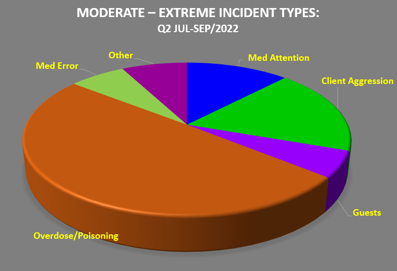Incidents and Safety Wins
Because of the service we provide, incidents are an inevitable part of worklife at GSS. Fortunately, incidents can help make the workplace safer. After a quick look at numbers and types, check out how some incidents are leading to changes in procedures, protocols, and security.
Incident Numbers and Types
The chart below compares incident report numbers for the first three quarters of 2022 and 2021 showing that reported incidents almost doubled. (One of the few silver linings to the pandemic may be the lower incident rates during that time.) A total of 624 incidents have been reported so far in 2022, compared to 333 during this time in 2021. The greatest increase was in the July to September quarter this year.
In looking at moderate to extreme incident types for the past quarter, the chart below shows that incidents associated with drug poisoning or overdose have taken the lead from client escalation/aggression and medical attention incidents. From July to September this year, of 182 incidents, half or 90 were associated with drug poisonings/overdoses. The downtown site has been the main location for drug-related incidents, but the Balwin site saw a spike in the past quarter. Client aggression continues to be the next highest moderate to extreme risk type with 33 or 18% of incidents over the past quarter.
Incident Reports Leading to Change
Incident reports can guide safety and procedure improvements in GSS programs and across the agency. Here are some examples from this year:
At Balwin, the drug overdose/poisonings have led to harm reduction conversations on a regular basis in all staff and resident meetings.
At SCS, a client brought a suitcase on site that led to some spread of bedbugs. Like residential and longer term GSS sites, SCS now has a bed bug prevention and response procedure.
Incidents involving unsafe substances or items being brought into MDU/POD led to programs updating their client safety and belongings check protocols based on best practice feedback from Edmonton Police Service partners.
At SCS, a client in psychosis gained access through the client entry door. That led to a change in staffing procedures to ensure that experienced staff were on shift with new staff and staff being retrained on de-escalation, site and door safety, and worksite protocols and procedures. Security was enhanced also with a new fence and a locking gate planned around the SCS entrance. Incidents like this also led to the POD/MDU/SCS site running some very thorough, cross-program emergency lockdown drills.
Medication errors are important learning and service improvement opportunities. At MDU, a client not taking meds for several days led to a new protocol that increases nursing check ins and assessment of patients as well as follow ups with clients who do not present for medications. At Cloverleaf, incidents have led to continuous medication administration training or coaching and shadowing for the team. Similarly, at Balwin, re-training, shadowing, and follow ups by the LPN and Team Lead almost eliminated staff-related med errors from one quarter to the next.
To reduce the physical or psychological risk associated with walking into residences where client safety is a concern, Housing First now ensures that a Team Lead or Manager is always present when staff act on a 24-Hour Notice of Entry. The team has also increased the number of EPS wellness checks. These involve calling the non-emergency line and asking for EPS to be dispatched to check on a participant who, for example, is a heavy opiate user and cannot be contacted.
Nonfatal work injuries and illness in healthcare services are among the highest of any industry sector. Completing, reviewing, and responding to incident reports at GSS is a vital part of reducing risk and supporting wellness for clients and staff. We couldn’t do that without the valuable incident reports prepared across programs. Keep up the great work!


